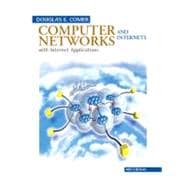
| Using and Building Internet Applications | |
| Introduction | |
| Motivation and Tools | |
| Network Programming and Applications | |
| Data Transmission | |
| Transmission Media | |
| Local Asynchronous Communication RS-232 | |
| Long-Distance Communication Carriers, Modulation, and Modems | |
| Packet Transmission | |
| Packets, Frames, and Error Detection | |
| LAN Technologies and Network Topology | |
| Hardware Addressing and Frame Type Identification | |
| LAN Wiring, Physical Topology, and Interface Hardware | |
| Extending LANs: Fiber Modems, Repeaters, Bridges, and Switches | |
| Long-Distance and Local Loop Digital Connection Technologies | |
| WAN Technologies and Routing | |
| Connection-Oriented Networking and ATM | |
| Network Characteristics: Ownership, Service Paradigm, and Performance | |
| Protocols and Layering | |
| Internetworking | |
| Internetworking: Concepts, Architecture, and Protocols | |
| IP: Internet Protocol Addresses | |
| Binding Protocol Addresses ARP | |
| IP Datagrams and Datagram Forwarding | |
| IP Encapsulation, Fragmentation, and Reassembly | |
| The Future IP IPv6 | |
| An Error Reporting Mechanism (CMP) | |
| UDP: Datagram Transport Service | |
| TCP: Reliable Transport Service | |
| Network Address Translation | |
| Internet Routing | |
| Network Applications | |
| Client-Server Interaction | |
| The Socket Interface | |
| Example of a Client and a Server | |
| Naming with the Domain Name System | |
| Electronic Mail Representation and Transfer | |
| IP Telephony VoIP | |
| File Transfer and Remote File Access | |
| World Wide Web Pages and Browsing | |
| Dynamic Web Document Technologies CGI, ASP, JSP, PHP, ColdFusion | |
| Active Web Document Technologies Java, JavaScript | |
| RPC and Middleware | |
| Network Management SNMP | |
| Network Security | |
| Initialization Configuration | |
| Glossary of Net | |
| Table of Contents provided by Publisher. All Rights Reserved. |
The New copy of this book will include any supplemental materials advertised. Please check the title of the book to determine if it should include any access cards, study guides, lab manuals, CDs, etc.
The Used, Rental and eBook copies of this book are not guaranteed to include any supplemental materials. Typically, only the book itself is included. This is true even if the title states it includes any access cards, study guides, lab manuals, CDs, etc.